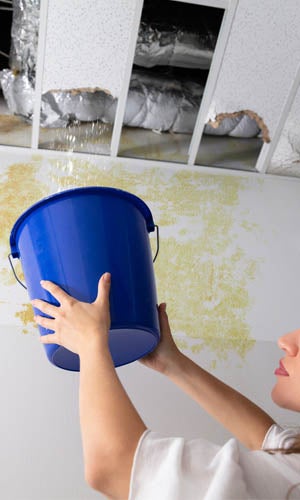What are your concepts about Locating water leaks?

Early detection of leaking water lines can reduce a possible calamity. Some tiny water leaks may not be noticeable.
1. Take A Look At the Water Meter
Every house has a water meter. Inspecting it is a surefire way that helps you find leaks. For starters, shut off all the water sources. Make sure no person will purge, make use of the tap, shower, run the cleaning equipment or dish washer. From there, most likely to the meter and watch if it will certainly transform. Considering that no person is utilizing it, there must be no movements. That suggests a fast-moving leak if it moves. Furthermore, if you detect no changes, wait a hr or two and also examine back once more. This indicates you may have a slow-moving leakage that might also be below ground.
2. Check Water Consumption
Assess your water bills as well as track your water usage. As the one paying it, you must observe if there are any type of disparities. If you identify sudden changes, despite your consumption being the same, it indicates that you have leakages in your plumbing system. Remember, your water expense ought to fall under the same range every month. A sudden spike in your bill indicates a fast-moving leak.
A steady boost every month, also with the exact same behaviors, shows you have a sluggish leak that's likewise slowly intensifying. Call a plumber to extensively examine your property, especially if you feel a warm location on your flooring with piping beneath.
3. Do a Food Coloring Test
30% comes from toilets when it comes to water intake. Test to see if they are running correctly. Decline specks of food shade in the storage tank as well as wait 10 minutes. There's a leakage in between the container and also bowl if the color somehow infiltrates your bowl throughout that time without flushing.
4. Asses Exterior Lines
Do not forget to examine your outdoor water lines also. Test spigots by affixing a yard pipe. Ought to water leak out of the link, you have a loosened rubber gasket. Replace this and make sure all links are limited. If you've obtained a lawn sprinkler, it will aid get it skillfully analyzed as well as preserved annually. One tiny leakage can lose lots of water as well as increase your water costs.
5. Examine and Analyze the Circumstance
Homeowners must make it a routine to inspect under the sink counters and also also inside closets for any bad odor or mold and mildew growth. These 2 warnings indicate a leak so prompt focus is required. Doing regular examinations, even bi-annually, can save you from a significant issue.
Much more notably, if you understand your residence is already old, keep a watchful eye on your heaters, hoses, pipes etc. Look for discolorations as well as damaging as many pipes as well as home appliances have a life span. They will also normally deteriorate because of deterioration. Don't wait for it to escalate if you think leaking water lines in your plumbing system. Call an expert plumber today so you do not wind up with a dreadful mess in your home.
Early detection of leaking water lines can mitigate a possible catastrophe. Some tiny water leaks might not be noticeable. Examining it is a guaranteed means that aids you find leakages. One little leakage can waste tons of water and increase your water costs.
If you presume dripping water lines in your plumbing system, don't wait for it to intensify.
How to Know If Your Home Has a Hidden Leak
Water Meter Reveals Inexplicable Water Usage
If you’d like to test whether or not there’s a leak somewhere in your home, you can do this using your water meter. Here is how to conduct the test:
Don’t use any water in your home for at least 30 minutes; this also means not turning on faucets or water-using appliances.
Go outside, and check your water meter for activity.
If your water meter shows that there was activity, even though no one was using any water, this proves that there is a leak in your home.Visible Mold or Mildew Growth
Leaks behind walls create moist, dark environments that allow mold and mildew to grow and thrive. Eventually, you might see mold growth forming on the wall closest to a hidden leak.
If mold is growing in an area that receives a high amount of moisture, such as a bathroom, it may simply be an indication that better ventilation is needed. However, if you see mold growth on a wall or the ceiling in an area where you would not expect, you probably have a hidden leak.
Musty, Mildew Odor
Sometimes you might not be able to see the mold or mildew that is growing as a result of a leak. However, the smell can give the problem away just as easily. If you catch a whiff of something musty, there’s a good chance that old water is collecting somewhere in your home that you can’t see.
Stained/Warped Walls, Ceilings, or Floors
When your home soaks up water, a variety of red flags can become visible, including ceiling stains, bubbling drywall, warped walls, and sagging floors. While these issues can be caused by excess humidity, they can also be signs that a pipe or plumbing connection has started leaking behind your walls.
Inexplicably High Water Bill
After a while, you get a general sense for what your water bill should be. If you own a pool or sprinkler system, your bill will tend to be higher during summer. However, if you receive a water bill that seems especially high, and you can’t figure out what caused it, then you may have a hidden leak somewhere that’s increasing your bill.
https://www.plumbingjoint.com/blog/2019/july/how-to-know-if-your-home-has-a-hidden-leak/

As an enthusiastic reader about Locating water leaks, I think sharing that post was essential. Sharing is good. Who knows, you may just be helping someone out. Thanks for your time invested reading it.